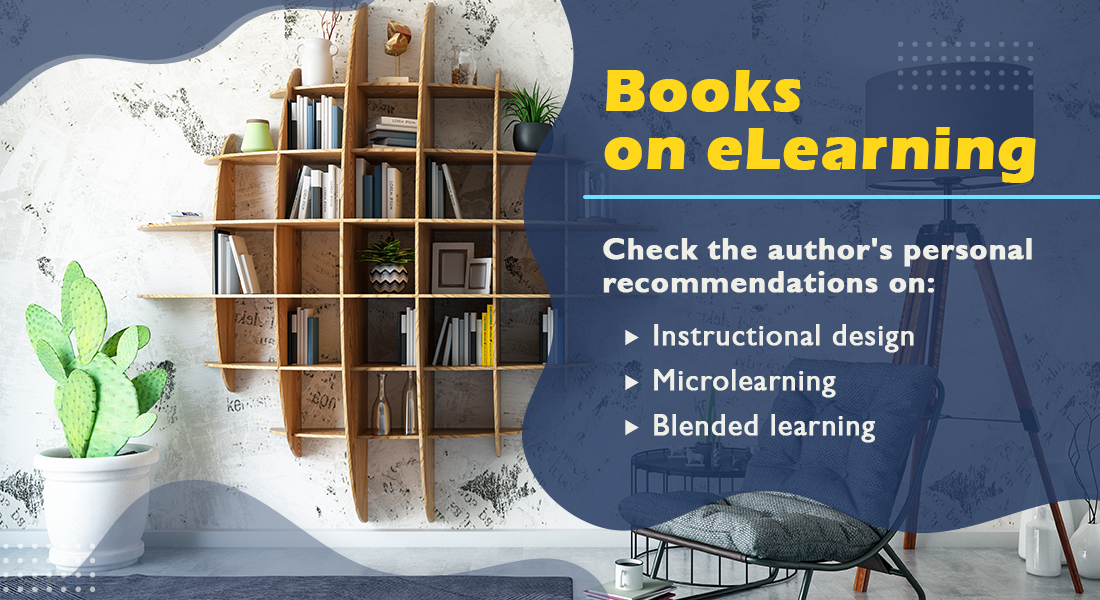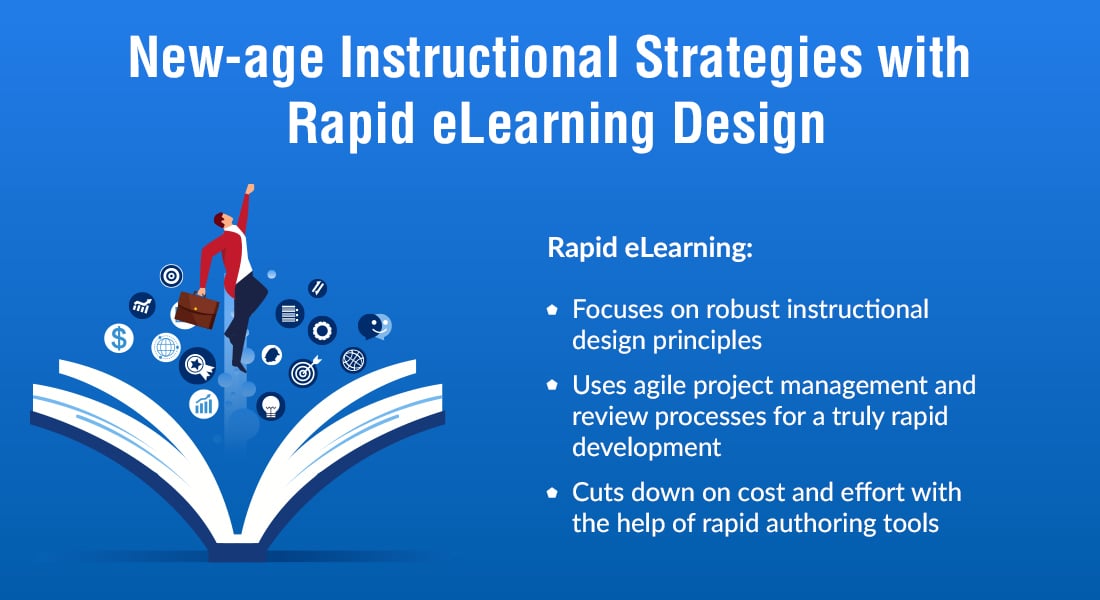6 Must-Reads About the eLearning Industry

Books are a warehouse of knowledge and information. eLearning is a vast and diverse field with years of accumulated knowledge and recent developments. It encompasses a wide range of aspects such as instructional design, microlearning, blended learning, and more.
As someone new to this world, I’ve been reading a lot and here is my personal recommendation of books (in no particular order) that cover the design aspects of eLearning in an easy-to-comprehend and implement way.
These books will give you insights and curb your curiosity about the eLearning world. They also provide you with necessary real-world information that can be seamlessly applied to your organization’s training programs.
Explore how you can become an eLearning champion in your organization.
My Recommended Book List on eLearning
- Michael Allen’s Guide to e-Learning by Michael W. Allen
- Agile for Instructional Designers: Iterative Project Management to Achieve Results by Megan Torrance
- e-Learning by Design by William Horton
- The Blended Learning Cookbook by Clive Shepherd
- Microlearning: Short and Sweet by Karl M. Kapp and Robyn A. Defelice
- Scenario-based e-Learning: Evidence-Based Guidelines for Online Workforce Learning by Ruth C. Clark and Richard E. Mayer
Will these Books Help Me?
The books mentioned in this list will be beneficial reads for new instructional designers and training managers. They will be interesting reads for anyone interested in learning more about online corporate training. Even experts can use these guides to aid implementation and drive innovation.
My Recommended Books on eLearning Strategies and Implementation
Michael Allen’s Guide to e-Learning by Michael W. Allen
About the Author
Michael Allen is an industry leader, educator, and software developer. Owing to his expertise, he is fondly referred to as the godfather of eLearning.
What You’ll Learn from the Book
The author imparts practical advice from his abundant experience in this wonderful guide to eLearning. There are plenty of strategies and best practices for designing interactive and engaging eLearning courses. The book highlights respecting learners’ time and providing them with the most efficient transfer of learning, while keeping in mind eLearning development time and cost.
Why I Recommend
Keeping Allen’s advice in mind, instructional designers can create cost-effective, interesting courses that keep up with the pace of technological development. The book released in January 2003 but is still relevant and has insights for beginners and advanced developers alike.
Agile for Instructional Designers: Iterative Project Management to Achieve Results by Megan Torrance
About the Author
Megan Torrance is the Chief Energy Officer of TorranceLearning. She has over 2 decades of experience in consulting, instructional design, and project management.
What You’ll Learn from the Book
Megan Torrance talks about how the ADDIE model is outdated and her own experience working with Agile. The introduction persuades team leaders to try Agile Project Management.
The book is neatly divided into three parts:
- The first part focuses on clearly defining the needs of the project at hand.
- The second part shares practical details and tips about managing the project.
- The third part illustrates how Agile can be applied in your organization.
Why I Recommend
Overall, the book serves as a useful guide for using Agile to manage eLearning projects for which traditional methods have failed. It also illustrates the practical ways in which the Agile principles benefit L&D professionals.
e-Learning by Design by William Horton
About the Author
William Horton has more than 35 years of hands-on experience in creating online educational curriculum. He has condensed his knowledge in multiple published volumes about eLearning, including the one discussed here.
What You’ll Learn from the Book
E-Learning by Design focuses on how to apply instructional design to eLearning. The book talks in detail about the purpose of eLearning and the importance of learning objectives. It contains practical advice on how to implement various Absorb-type and Do-type activities in eLearning courses. It also shares insights on designing virtual classroom activities, performance support tools, and integrating social learning in eLearning.
Why I Recommend
Packed with detailed instructions to improve learning and retention, this book will add great value to any online training course. The numerous ways in which it helps improve learner engagement is another thing to appreciate and value.
The Blended Learning Cookbook by Clive Shepherd
About the Author
Clive Shepherd is a consulting specialist in e-learning, blended learning, and business communications. He is a learning technologist with more than 30 years of experience.
What You’ll Learn from the Book
In this book, myths about blended learning are busted and replaced with knowledge, insights, and useful advice.
In the author’s words, this is how the book came about – “Well, if you were a chef and travelled to a country where they only ever ate sandwiches, then you’d spot the need for a cookbook. That’s how I saw it with blended learning. There are simply too many sandwiches – you know, a bit of e-learning as pre-work, the same old classroom course, a bit of e-learning to follow-up. The best way to help trainers to think creatively is with examples, so I’ve put together a cookbook and stuffed it with recipes.”
Why I Recommend
The Blended Learning Cookbook will help readers use their imagination to combine the various training formats at their disposal – formal and informal, synchronous and asynchronous – to design a blended solution for each training need.
Microlearning: Short and Sweet by Karl M. Kapp and Robyn A. Defelice
About the Authors
Karl M. Kapp is an Instructional Technology Professor at Bloomsburg University and the author of ‘The Gamification of Learning and Instruction Fieldbook’. Robyn A. Defelice is a strategist and consultant in the learning and performance arena.
What You’ll Learn from the Book
This book puts microlearning into action. It takes the micro way to talk for microlearning with:
- Short text
- Key takeaways
- Case studies and examples
It also highlights when to use microlearning, when not to use it, the pitfalls to avoid, and more.
Why I Recommend
This book helps readers with the entire spectrum of microlearning implementation – from the how and when to the design, development, and evaluation.
Scenario-based e-Learning: Evidence-Based Guidelines for Online Workforce Learning by Ruth C. Clark and Richard E. Mayer
About the Authors
Ruth C. Clark has a doctorate in instructional psychology from USC, is a Past President of the International Society of Performance Improvement and a member of the American Educational Research Association. Richard E. Mayer is an educational psychologist known for his contributions to the field of problem solving.
What You’ll Learn from the Book
The book focuses on the what, when, and how of scenario-based eLearning (SBeL) for workforce learning. It offers insights on:
- Determining when to use scenario-based eLearning
- Aligning SBeL with organizational goals
- Making a business case for SBeL
- Applying a design model to present content in a task-centered context
Why I Recommend
The book evaluates the effectiveness of SBeL, giving training managers a complete picture of when to opt for the method.
Wrap Up
There you have it – my list of recommendations on eLearning design. These books will help you quickly get up to speed with eLearning. Wait… if you are thinking how to manage reading all these books, here’s a simple alternative.
Check our practical implementation guide on eLearning which distills 20 years’ experience working on eLearning projects for multiple customers across industries, on a wide range of topics.
It will offer insights on aligning training with business goals, eLearning trends, converting instructor-led training to eLearning, popular instructional design strategies, levels of eLearning interactivities, choosing the right authoring tool, and more.




![What are the Intuitive Design Aspects for Impactful eLearning? [Infographic]](https://blog.commlabindia.com/hubfs/blogs/intuitive-design-aspects-impactful-elearning-info.jpg)

